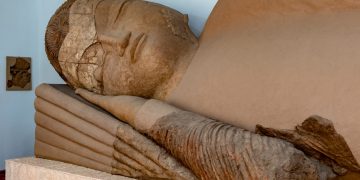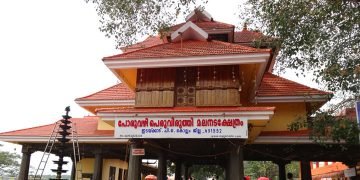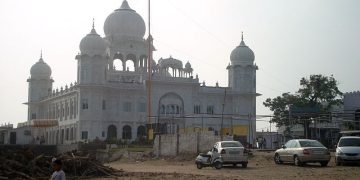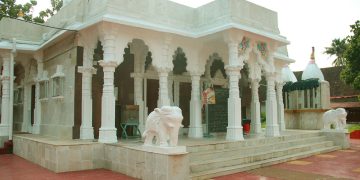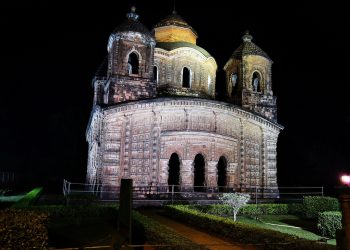Amaralingeswara Swamy temple is located in Amararama which is one of the Pancharama Kshetras which is located at Amaravati town near Guntur City in Andhra Pradesh in southern India. Lord Shiva is known as Amareswara Swamy or Amaralingeswara Swamy here. The temple is situated on the southern bank of Krishna River. The consort of Lord Amareswara Swamy is Bala Chamundika. The Sivalinga at this place is installed and established by Lord Indra. The temple is closed between 1PM and 4PM every day.
Shrine’s History
Vasireddy Venkatadri Naidu, King of Chintapalli and later Dharanikota, was a great devotee of Amaralingeswara. He expanded and renovated the temple. The popular legend has it that once during the course of putting down a rebellion in his land the King had to have recourse to a massacre of the Chenchus, whereupon he lost his mental peace, which he regained only when he came to Amaravati. He shifted his place from Chintapalli to Amaravati in 1796 and devoted his entire life, time and revenues to building temples for Lord Siva.
He renovated the Amareswaraswamy temple here, engaged nine learned archakas for the daily Archana of the Lord, and provided them with all the needs of livelihood, including 12 acres (49,000 m2) of land to each. The temple as it stands owes much to him. Skanda Purana tells the story of the temple. The sthalapurana for the temple is an interesting story. At the end of Dwaparayuga 5053 years ago, Maharishi Narada was asked by the Sounakadi rishis as to the best means to obtain liberation. Narada told them that as Lord Krishna had created the river Krishna, so had he advised the rishis to live near the river and bathe in its holy water to attain salvation. If a devotee remains in this area for more than three days and worships Lord Amareswara with devotion, after a dip in the holy river, he will attain salvation. If a devotee dies here, he will be absorbed into Lord Shiva. There are much more legends from the Kshetra mahatmyam and the Kshetramurthy Mahatmyam.
Once there was a town called Dhanyakatakam or Varanasi. The legend says that the demons defeated the gods after being awarded a boon by Lord Shiva. Shiva vowed to kill the demons and hence the gods came to reside here and since then the place came to be called Amaravati. Lord Amareswara is worshipped here with his consort Bala Chamundika who is considered as the fourth of the 18 goddesses. There are other minor deities in the temple.
.jpg)
Legends Associated with This Shrine
Legend says that the temple was originally Buddhist and was adapted for Hindu worship. Hence the foundations are laid in Buddhist style. The Mula Virat in the sanctum has a white marble lotus medallion, made in an ornate style of the early Buddhist sculptors. The Mula Virat is a vertical cylinder made of white marble as found in Buddhist monuments.

Architectural Relevance of This Shrine
This Amaravati temple is devoted to Lord Shiva and homes 15 feet high white marble Shiva symbol. On the four sides of the Amaravati temple are large gopurams in a usually Dravidian architectural style. As per the Hindu mythology, Amareswara, Amaravati temple is devoted to Lord Shiva, the ‘destroyer of the Universe’. The Amareswara Swamy temple is found on little hammock named as Krouncha Shaila in Amaravati, concerning fifteen miles, far away from Guntur, nearest to Vijayawada in Andhra Pradesh. This Amaravati temple constitutes one of the 5 Pancharama temples of Andhra Pradesh dedicated to Lord Shiva.
The other four of Pancharama temples are Kumararama, Ksheerarama and Bheemarama and Draksharama. This ancient temple is dedicated to Shiva and enshrines a 15 feet high white marble Linga, surrounded by massive walls with towers. The temple stands close to the Krishna river. The origin is shrouded in mystery, though there are many legends in the Puranas. The temple is surrounded on all four sides by towering gopurams in Dravidian style. The vimana is also in the same style. The Linga is 15 feet tall, another legend states that this was originally the Ayaka Stambha or an Ayaka pillar, and which was later consecrated as a symbol of the Shivalinga. The temple is a perfect example of the Dravidian style.
The gopuras came into prominence, only during medieval times and no stone epigraph is found before the 11th century suggesting its late origin. There is a wealth of inscription on its walls by Kota chiefs of Amaravati, and one by Krishandevaraya on the erection of a mandapam here. On a pillar in the Mukhamantapa, the wife of Proli Nayudu, dependent of Koppara Kesanivarma, has left an inscription.
Shrine’s Map Location and How to Go There
By Road
State-run APSRTC connects the Amaravati with the district headquarters, Guntur and many other towns and cities like Vijayawada, Mangalagiri, Sattenapalle, Hyderabad etc. Amaravati is at 35kms distance from Guntur. There are so many non-stop buses from Guntur. It takes about 45 minutes journey. Buses will leave us at a temple. In Karthika Masam APSRTC maintains special Pancharamas tour buses to cover them all in a single day.
By Rail
Pedakurapadu is the nearest railway station under Guntur railway division of South Central Railway zone
By Air
To reach the place by Air the nearest airport is Vijayawada (82 km).
Shrine Timings
06:00 to 21:00 All days of the week
Events Celebrated at This Shrine
Maha Shivaratri of Magha Bahula Dasami is that the major festival celebrated here. The divine aura of the shrine attracts thousands of pilgrims every year.
Extra Information About this Shrine
Use of cell phones is restricted normally. Photography is restricted in some temples. Avoid shorts, skirts, tank tops and do not expose legs. Footwear to be left outside the temple. In summer be careful of the hot paving stones. Entry is normally restricted to temple priests in the sanctum sanctorum. Some temples restrict the entry of non-Hindus. Devotees are to walk around the sanctum sanctorum in a clockwise direction.



